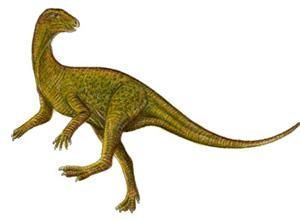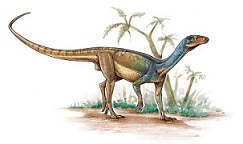
Pisanosaurus is a genus of early dinosaur that lived during the Late Triassic period, around 228 million years ago. It's significant because it's considered one of the earliest known dinosaurs, showcasing the beginnings of the dinosaur lineage.
Pisanosaurus is one of the earliest dinosaurs, representing a crucial point in the evolution of these magnificent creatures. Its discovery has helped scientists understand the origins and early diversification of dinosaurs.
| Name: | Pisanosaurus dinosaurs |
| Size: | Around 1.2 meters (4 feet) in length. |
| Main Facts: | Pisanosaurus is one of the earliest known dinosaurs, offering insights into the early evolution of these iconic creatures during the Late Triassic. |
Pisanosaurus lived during the Late Triassic when the Earth's continents were still connected in the supercontinent Pangaea. The environment was very different from what we see today, with vast deserts and lush forests.

Pisanosaurus was a relatively small dinosaur, measuring about 1.2 meters (4 feet) in length. It had a bipedal stance, walking on two legs, and possessed a beak-like mouth, suggesting an herbivorous diet.
While the exact details of its diet aren't known, Pisanosaurus is believed to have been an herbivore, feeding on plants and vegetation that were present during the Late Triassic.
Fossils of Pisanosaurus were discovered in the Ischigualasto Formation in Argentina, which is renowned for its rich deposits of Late Triassic fossils, providing insights into the ancient ecosystems of the time.
Pisanosaurus has helped scientists understand the transition from early reptiles to true dinosaurs. Its anatomy holds clues about the development of dinosaur characteristics.
Pisanosaurus' relatively small size is a contrast to the colossal dinosaurs that would dominate later periods. Its existence illustrates the diversity of dinosaurs during their early stages..
Pisanosaurus, a dinosaur of great significance in the study of prehistoric life, offers a glimpse into the early stages of dinosaur evolution during the Late Triassic period, around 228 million years ago. This small dinosaur, measuring about 1.2 meters (4 feet) in length, was a bipedal herbivore that walked on two legs and had a beak-like mouth adapted for plant consumption.Its fossils, discovered in the Ischigualasto Formation of Argentina, have helped paleontologists understand the transition from early reptiles to true dinosaurs.
>Pisanosaurus holds clues to the development of key dinosaurian characteristics, such as upright posture and herbivory.In a world vastly different from today's, with Pangaea as the supercontinent and a unique Triassic environment, Pisanosaurus represents an essential part of the ancient ecosystem. Its modest size stands in stark contrast to the colossal dinosaurs of later periods, illustrating the early diversity among these remarkable creatures.
Pisanosaurus is one of the earliest known dinosaurs, allowing scientists to study the foundational traits of dinosaurs. Comparing it to other early dinosaurs reveals the gradual development of features like bipedal locomotion.
Pisanosaurus was relatively small, especially when compared to later dinosaurs. Contrasting it with larger herbivores like sauropodomorphs shows the diversity in size and adaptations among early dinosaurs.
Pisanosaurus was an herbivore, similar to many later dinosaurs. Comparing its herbivorous adaptations, such as its beak-like mouth, with those of later herbivorous dinosaurs reveals the continuity in feeding strategies.
Pisanosaurus lived in the Late Triassic period, alongside other early dinosaurs and reptiles. Comparing its role in these ancient ecosystems to that of later dinosaurs showcases changing predator-prey relationships and ecosystem dynamics.
Comparing the distribution of Pisanosaurus in South America with the locations of other early dinosaurs around the world provides insights into the biogeography of these ancient creatures.
Pisanosaurus is crucial for understanding the evolutionary lineage of dinosaurs. Comparing it to later, more derived dinosaurs helps trace the development of key dinosaurian traits.
Contrasting the small size of Pisanosaurus with the immense size of sauropods or theropods highlights the wide range of body sizes that dinosaurs would eventually evolve.